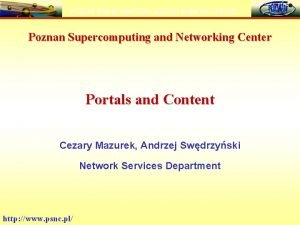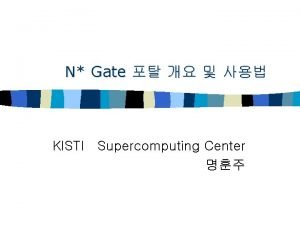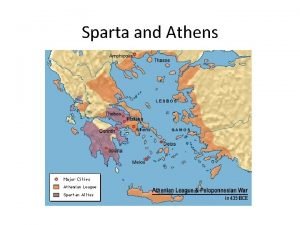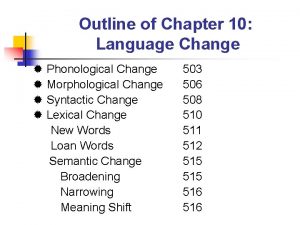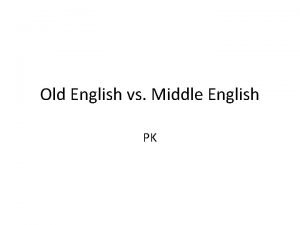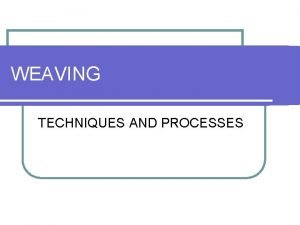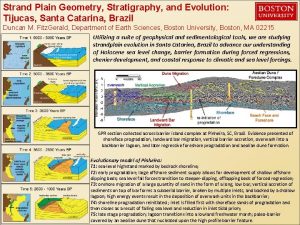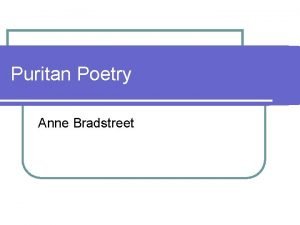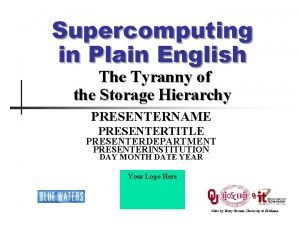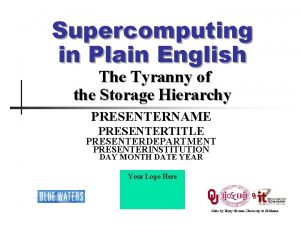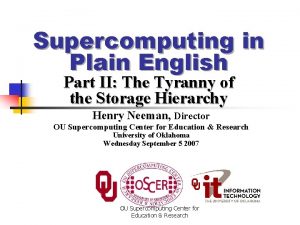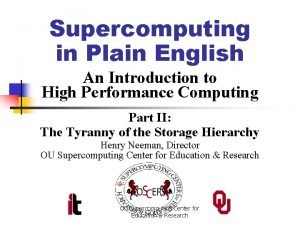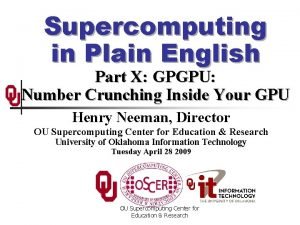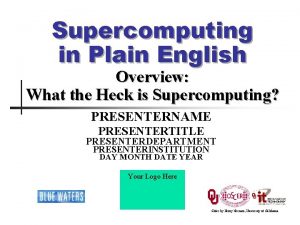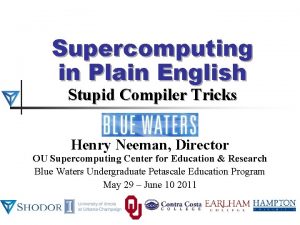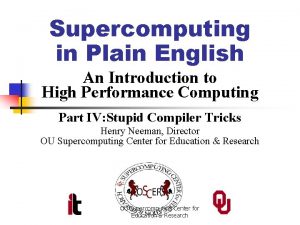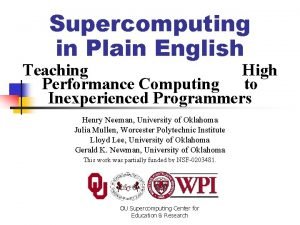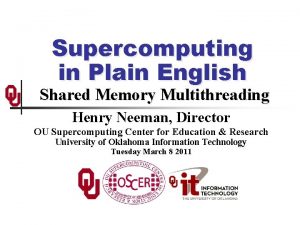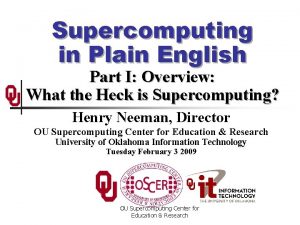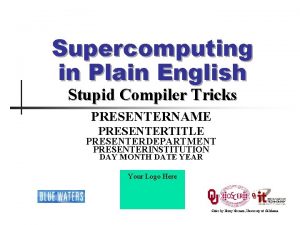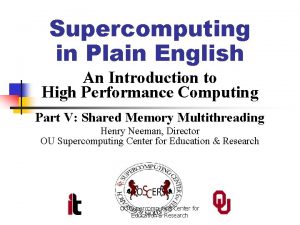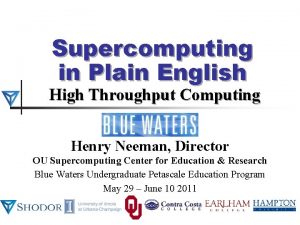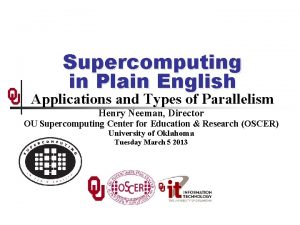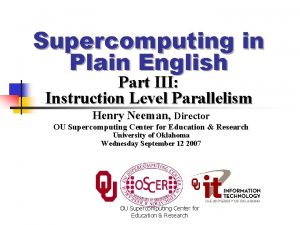Supercomputing in Plain English The Tyranny of the
















![A Laptop Dell Latitude Z 600[4] n n n Intel Core 2 Duo SU A Laptop Dell Latitude Z 600[4] n n n Intel Core 2 Duo SU](https://slidetodoc.com/presentation_image_h2/5f513ad40be9d799543770e09b6b16d6/image-17.jpg)

![Registers [25] Registers [25]](https://slidetodoc.com/presentation_image_h2/5f513ad40be9d799543770e09b6b16d6/image-19.jpg)



![Cache [4] Cache [4]](https://slidetodoc.com/presentation_image_h2/5f513ad40be9d799543770e09b6b16d6/image-23.jpg)

![From Cache to the CPU 307 GB/sec[7] 27 GB/sec (6 x RAM)[7] Cache Typically, From Cache to the CPU 307 GB/sec[7] 27 GB/sec (6 x RAM)[7] Cache Typically,](https://slidetodoc.com/presentation_image_h2/5f513ad40be9d799543770e09b6b16d6/image-25.jpg)


![Cache & RAM Latencies Better [26] Supercomputing in Plain English: Storage Hierarchy Tue Feb Cache & RAM Latencies Better [26] Supercomputing in Plain English: Storage Hierarchy Tue Feb](https://slidetodoc.com/presentation_image_h2/5f513ad40be9d799543770e09b6b16d6/image-28.jpg)
![Main Memory [13] Main Memory [13]](https://slidetodoc.com/presentation_image_h2/5f513ad40be9d799543770e09b6b16d6/image-29.jpg)





![Cache & RAM Bandwidths Better [26] Supercomputing in Plain English: Storage Hierarchy Tue Feb Cache & RAM Bandwidths Better [26] Supercomputing in Plain English: Storage Hierarchy Tue Feb](https://slidetodoc.com/presentation_image_h2/5f513ad40be9d799543770e09b6b16d6/image-35.jpg)














![Cache Associativity Examples n Core 2 Duo [26] n n n 8 -way set Cache Associativity Examples n Core 2 Duo [26] n n n 8 -way set](https://slidetodoc.com/presentation_image_h2/5f513ad40be9d799543770e09b6b16d6/image-50.jpg)



![Cache Store Examples n Core 2 Duo [26] n n L 1 cache: write-back Cache Store Examples n Core 2 Duo [26] n n L 1 cache: write-back](https://slidetodoc.com/presentation_image_h2/5f513ad40be9d799543770e09b6b16d6/image-54.jpg)
![The Importance of Being Local [15] The Importance of Being Local [15]](https://slidetodoc.com/presentation_image_h2/5f513ad40be9d799543770e09b6b16d6/image-55.jpg)










































![References [1] http: //graphics 8. nytimes. com/images/2007/07/13/sports/auto 600. gif [2] http: //www. vw. com/newbeetle/ References [1] http: //graphics 8. nytimes. com/images/2007/07/13/sports/auto 600. gif [2] http: //www. vw. com/newbeetle/](https://slidetodoc.com/presentation_image_h2/5f513ad40be9d799543770e09b6b16d6/image-98.jpg)
- Slides: 98

Supercomputing in Plain English The Tyranny of the Storage Hierarchy Henry Neeman, Director OU Supercomputing Center for Education & Research University of Oklahoma Information Technology Tuesday February 15 2011

This is an experiment! It’s the nature of these kinds of videoconferences that FAILURES ARE GUARANTEED TO HAPPEN! NO PROMISES! So, please bear with us. Hopefully everything will work out well enough. If you lose your connection, you can retry the same kind of connection, or try connecting another way. Remember, if all else fails, you always have the toll free phone bridge to fall back on. Supercomputing in Plain English: Storage Hierarchy Tue Feb 15 2011 2

Access Grid If you aren’t sure whether you have AG, you probably don’t. Tue Feb 15 Walkabout Tue Feb 22 Optiverse Tue March 1 Walkabout Tue March 8 NO WORKSHOP Tue March 15 NO WORKSHOP Tue March 22 Axon Tue March 29 NO WORKSHOP Tue Apr 5 Axon Tue Apr 12 Platinum Tue Apr 19 Mosaic Tue Apr 26 Monte Carlo Tue May 3 Helium Many thanks to Patrick Calhoun of OU for setting these up for us. Supercomputing in Plain English: Storage Hierarchy Tue Feb 15 2011 3

H. 323 (Polycom etc) If you want to use H. 323 videoconferencing – for example, Polycom – then: n If you ARE already registered with the One. Net gatekeeper, dial 2500409. n If you AREN’T registered with the One. Net gatekeeper (which is probably the case), then: n n n Dial 164. 58. 250. 47 On some H. 323 units, you may need to hit # to bring up the keypad. When asked for the conference ID, enter: 0409# Many thanks to Roger Holder and One. Net for providing this. Supercomputing in Plain English: Storage Hierarchy Tue Feb 15 2011 4

H. 323 from Internet Explorer From a Windows PC running Internet Explorer: 1. You MUST have the ability to install software on the PC (or have someone install it for you). 2. Download and install the latest Java Runtime Environment (JRE) from here (click on the Java Download icon, because that install package includes both the JRE and other components). 3. Download and install this video decoder. 4. Start Internet Explorer. 5. Copy-and-paste this URL into your IE window: http: //164. 58. 250. 47/ 6. When that webpage loads, in the upper left, click on "Streaming". 7. In the textbox labeled Sign-in Name, type your name. 8. In the textbox labeled Conference ID, type this: 0409 9. Click on "Stream this conference". 10. When that webpage loads, you may see, at the very top, a bar offering you options. If so, click on it and choose "Install this add-on. " Supercomputing in Plain English: Storage Hierarchy Tue Feb 15 2011 5

EVO There’s a quick tutorial on the OSCER education webpage. Supercomputing in Plain English: Storage Hierarchy Tue Feb 15 2011 6

Quick. Time Broadcaster If you cannot connect via the Access Grid, H. 323 or i. Linc, then you can connect via Quick. Time: rtsp: //129. 15. 254. 141/test_hpc 09. sdp We recommend using Quick. Time Player for this, because we’ve tested it successfully. We recommend upgrading to the latest version at: http: //www. apple. com/quicktime/ When you run Quick. Time Player, traverse the menus File -> Open URL Then paste in the rstp URL into the textbox, and click OK. Many thanks to Kevin Blake of OU for setting up Quick. Time Broadcaster for us. Supercomputing in Plain English: Storage Hierarchy Tue Feb 15 2011 7

Web. Ex We have only a limited number of Web. Ex connections, so please avoid Web. Ex unless you have NO OTHER WAY TO CONNECT. Instructions are available on the OSCER education webpage. Thanks to Tim Miller of Wake Forest U. Supercomputing in Plain English: Storage Hierarchy Tue Feb 15 2011 8

Phone Bridge If all else fails, you can call into our toll free phone bridge: 1 -866 -285 -7778, access code 6483137# Please mute yourself and use the phone to listen. Don’t worry, we’ll call out slide numbers as we go. Please use the phone bridge ONLY if you cannot connect any other way: the phone bridge is charged per connection per minute, so our preference is to minimize the number of connections. Many thanks to Amy Apon and U Arkansas for providing the toll free phone bridge. Supercomputing in Plain English: Storage Hierarchy Tue Feb 15 2011 9

Please Mute Yourself No matter how you connect, please mute yourself, so that we cannot hear you. At OU, we will turn off the sound on all conferencing technologies. That way, we won’t have problems with echo cancellation. Of course, that means we cannot hear questions. So for questions, you’ll need to send some kind of text. Supercomputing in Plain English: Storage Hierarchy Tue Feb 15 2011 10

Questions via Text: i. Linc or E-mail Ask questions via e-mail to sipe 2011@yahoo. com. All questions will be read out loud and then answered out loud. Supercomputing in Plain English: Storage Hierarchy Tue Feb 15 2011 11

Thanks for helping! n n n n OSCER operations staff (Brandon George, Dave Akin, Brett Zimmerman, Josh Alexander) Horst Severini, OSCER Associate Director for Remote & Heterogeneous Computing OU Research Campus staff (Patrick Calhoun, Mark Mc. Avoy) Kevin Blake, OU IT (videographer) John Chapman, Jeff Pummill and Amy Apon, U Arkansas James Deaton and Roger Holder, One. Net Tim Miller, Wake Forest U Jamie Hegarty Schwettmann, i 11 Industries Supercomputing in Plain English: Storage Hierarchy Tue Feb 15 2011 12

This is an experiment! It’s the nature of these kinds of videoconferences that FAILURES ARE GUARANTEED TO HAPPEN! NO PROMISES! So, please bear with us. Hopefully everything will work out well enough. If you lose your connection, you can retry the same kind of connection, or try connecting another way. Remember, if all else fails, you always have the toll free phone bridge to fall back on. Supercomputing in Plain English: Storage Hierarchy Tue Feb 15 2011 13

Supercomputing Exercises Want to do the “Supercomputing in Plain English” exercises? n The first exercise is already posted at: http: //www. oscer. ou. edu/education. php n If you don’t yet have a supercomputer account, you can get a temporary account, just for the “Supercomputing in Plain English” exercises, by sending e-mail to: hneeman@ou. edu Please note that this account is for doing the exercises only, and will be shut down at the end of the series. n This week’s Tiling exercise will give you experience optimizing performance by finding the best tile size. Supercomputing in Plain English: Storage Hierarchy Tue Feb 15 2011 14

Outline n n n n What is the storage hierarchy? Registers Cache Main Memory (RAM) The Relationship Between RAM and Cache The Importance of Being Local Hard Disk Virtual Memory Supercomputing in Plain English: Storage Hierarchy Tue Feb 15 2011 15

The Storage Hierarchy Fast, expensive, few n n n Slow, cheap, a lot n Registers Cache memory Main memory (RAM) Hard disk Removable media (CD, DVD etc) Internet [5] Supercomputing in Plain English: Storage Hierarchy Tue Feb 15 2011 16
![A Laptop Dell Latitude Z 6004 n n n Intel Core 2 Duo SU A Laptop Dell Latitude Z 600[4] n n n Intel Core 2 Duo SU](https://slidetodoc.com/presentation_image_h2/5f513ad40be9d799543770e09b6b16d6/image-17.jpg)
A Laptop Dell Latitude Z 600[4] n n n Intel Core 2 Duo SU 9600 1. 6 GHz w/3 MB L 2 Cache 4 GB 1066 MHz DDR 3 SDRAM 256 GB SSD Hard Drive DVD+RW/CD-RW Drive (8 x) 1 Gbps Ethernet Adapter Supercomputing in Plain English: Storage Hierarchy Tue Feb 15 2011 17

Storage Speed, Size, Cost Laptop Registers (Intel Core 2 Duo 1. 6 GHz) Cache Memory (L 2) Main Memory (1066 MHz DDR 3 SDRAM) Hard Drive (SSD) Ethernet (1000 Mbps) Speed (MB/sec) [peak] 314, 573[6] (12, 800 MFLOP/s*) 27, 276 [7] 4500 [7] 250 125 Size (MB) 464 bytes** 3 4096 256, 000 $285 [13] $0. 03 $0. 002 Cost ($/MB) [9] DVD+R (16 x) Phone Modem (56 Kbps) 22 0. 007 unlimited charged per month (typically) $0. 00005 charged per month (typically) [10] [11] – [12] * MFLOP/s: millions of floating point operations per second ** 16 64 -bit general purpose registers, 8 80 -bit floating point registers, 16 128 -bit floating point vector registers Supercomputing in Plain English: Storage Hierarchy Tue Feb 15 2011 18
![Registers 25 Registers [25]](https://slidetodoc.com/presentation_image_h2/5f513ad40be9d799543770e09b6b16d6/image-19.jpg)
Registers [25]

What Are Registers? Registers are memory-like locations inside the Central Processing Unit that hold data that are being used right now in operations. CPU Control Unit Fetch Next Instruction Fetch Data Store Data Arithmetic/Logic Unit Add Sub Mult Div And Or Not … Increment Instruction Ptr Execute Instruction … Supercomputing in Plain English: Storage Hierarchy Tue Feb 15 2011 Registers Integer Floating…Point … 20

How Registers Are Used n n Every arithmetic or logical operation has one or more operands and one result. Operands are contained in source registers. A “black box” of circuits performs the operation. The result goes into a destination register. operand Register Ri result operand Register Rj Register Rk Example: Operation circuitry addend in R 0 augend in R 1 5 7 ADD 12 Supercomputing in Plain English: Storage Hierarchy Tue Feb 15 2011 sum in R 2 21

How Many Registers? Typically, a CPU has less than 8 KB (8192 bytes) of registers, usually split into registers for holding integer values and registers for holding floating point (real) values, plus a few special purpose registers. Examples: n IBM POWER 7 (found in IBM p-Series supercomputers): 226 64 -bit integer registers and 348 128 -bit merged vector/scalar registers (7376 bytes) [28] n Intel Core 2 Duo: 16 64 -bit general purpose registers, 8 80 -bit floating point registers, 16 128 -bit floating point vector registers (464 bytes) [11] n Intel Itanium 2: 128 64 -bit integer registers, 128 82 -bit floating point registers (2304 bytes) [23] Supercomputing in Plain English: Storage Hierarchy Tue Feb 15 2011 22
![Cache 4 Cache [4]](https://slidetodoc.com/presentation_image_h2/5f513ad40be9d799543770e09b6b16d6/image-23.jpg)
Cache [4]

What is Cache? n n n A special kind of memory where data reside that are about to be used or have just been used. Very fast => very expensive => very small (typically 100 to 10, 000 times as expensive as RAM per byte) Data in cache can be loaded into or stored from registers at speeds comparable to the speed of performing computations. Data that are not in cache (but that are in Main Memory) take much longer to load or store. Cache is near the CPU: either inside the CPU or on the motherboard that the CPU sits on. Supercomputing in Plain English: Storage Hierarchy Tue Feb 15 2011 24
![From Cache to the CPU 307 GBsec7 27 GBsec 6 x RAM7 Cache Typically From Cache to the CPU 307 GB/sec[7] 27 GB/sec (6 x RAM)[7] Cache Typically,](https://slidetodoc.com/presentation_image_h2/5f513ad40be9d799543770e09b6b16d6/image-25.jpg)
From Cache to the CPU 307 GB/sec[7] 27 GB/sec (6 x RAM)[7] Cache Typically, data move between cache and the CPU at speeds relatively near to that of the CPU performing calculations. Supercomputing in Plain English: Storage Hierarchy Tue Feb 15 2011 25

Multiple Levels of Cache Most contemporary CPUs have more than one level of cache. For example: n Intel Pentium 4 EM 64 T (Yonah) [? ? ] n n n Level 1 caches: 32 KB instruction, 32 KB data Level 2 cache: 2048 KB unified (instruction+data) IBM POWER 7 [28] n n n Level 1 cache: 32 KB instruction, 32 KB data per core Level 2 cache: 256 KB unified per core Level 3 cache: 4096 KB unified per core Supercomputing in Plain English: Storage Hierarchy Tue Feb 15 2011 26

Why Multiple Levels of Cache? The lower the level of cache: n the faster the cache can transfer data to the CPU; n the smaller that level of cache is (faster => more expensive => smaller). Example: IBM POWER 7 latency to the CPU [28] n L 1 cache: 1 cycle = 0. 29 ns for 3. 5 GHz n L 2 cache: 8. 5 cycles = 2. 43 ns for 3. 5 GHz (average) n L 3 cache: 23. 5 cycles = 5. 53 ns for 3. 5 GHz (local to core) n RAM: 346 cycles = 98. 86 ns for 3. 5 GHz (1066 MHz RAM) Example: Intel Itanium 2 latency to the CPU [19] n L 1 cache: 1 cycle = 1. 0 ns for 1. 0 GHz n L 2 cache: 5 cycles = 5. 0 ns for 1. 0 GHz n L 3 cache: 12 -15 cycles = 12 – 15 ns for 1. 0 GHz Example: Intel Pentium 4 (Yonah) n L 1 cache: 3 cycles = 1. 64 ns for a 1. 83 GHz CPU = 12 calculations n L 2 cache: 14 cycles = 7. 65 ns for a 1. 83 GHz CPU = 56 calculations n RAM: 48 cycles = 26. 2 ns for a 1. 83 GHz CPU = 192 calculations Supercomputing in Plain English: Storage Hierarchy Tue Feb 15 2011 27
![Cache RAM Latencies Better 26 Supercomputing in Plain English Storage Hierarchy Tue Feb Cache & RAM Latencies Better [26] Supercomputing in Plain English: Storage Hierarchy Tue Feb](https://slidetodoc.com/presentation_image_h2/5f513ad40be9d799543770e09b6b16d6/image-28.jpg)
Cache & RAM Latencies Better [26] Supercomputing in Plain English: Storage Hierarchy Tue Feb 15 2011 28
![Main Memory 13 Main Memory [13]](https://slidetodoc.com/presentation_image_h2/5f513ad40be9d799543770e09b6b16d6/image-29.jpg)
Main Memory [13]

What is Main Memory? n n Where data reside for a program that is currently running Sometimes called RAM (Random Access Memory): you can load from or store into any main memory location at any time Sometimes called core (from magnetic “cores” that some memories used, many years ago) Much slower => much cheaper => much bigger Supercomputing in Plain English: Storage Hierarchy Tue Feb 15 2011 30

What Main Memory Looks Like … 0 1 2 3 4 5 6 7 8 9 10 536, 870, 911 You can think of main memory as a big long 1 D array of bytes. Supercomputing in Plain English: Storage Hierarchy Tue Feb 15 2011 31

The Relationship Between Main Memory & Cache

RAM is Slow The speed of data transfer between Main Memory and the CPU is much slower than the speed of calculating, so the CPU spends most of its time waiting for data to come in or go out. CPU 307 GB/sec[6] Bottleneck 4. 4 GB/sec[7] (1. 4%) Supercomputing in Plain English: Storage Hierarchy Tue Feb 15 2011 33

Why Have Cache? Cache is much closer to the speed of the CPU, so the CPU doesn’t have to wait nearly as long for stuff that’s already in cache: it can do more operations per second! CPU 27 GB/sec (9%)[7] 4. 4 GB/sec[7] (1%) Supercomputing in Plain English: Storage Hierarchy Tue Feb 15 2011 34
![Cache RAM Bandwidths Better 26 Supercomputing in Plain English Storage Hierarchy Tue Feb Cache & RAM Bandwidths Better [26] Supercomputing in Plain English: Storage Hierarchy Tue Feb](https://slidetodoc.com/presentation_image_h2/5f513ad40be9d799543770e09b6b16d6/image-35.jpg)
Cache & RAM Bandwidths Better [26] Supercomputing in Plain English: Storage Hierarchy Tue Feb 15 2011 35

Cache Use Jargon Cache Hit: the data that the CPU needs right now are already in cache. n Cache Miss: the data that the CPU needs right now are not currently in cache. If all of your data are small enough to fit in cache, then when you run your program, you’ll get almost all cache hits (except at the very beginning), which means that your performance could be excellent! Sadly, this rarely happens in real life: most problems of scientific or engineering interest are bigger than just a few MB. n Supercomputing in Plain English: Storage Hierarchy Tue Feb 15 2011 36

Cache Lines n n n A cache line is a small, contiguous region in cache, corresponding to a contiguous region in RAM of the same size, that is loaded all at once. Typical size: 32 to 1024 bytes Examples n Core 2 Duo [26] n n n L 1 data cache: L 2 cache: 64 bytes per line POWER 7 [28] n n L 1 instruction cache: L 1 data cache: L 2 cache: L 3 cache: 128 bytes per line 128 bytes per line Supercomputing in Plain English: Storage Hierarchy Tue Feb 15 2011 37

How Cache Works When you request data from a particular address in Main Memory, here’s what happens: 1. The hardware checks whether the data for that address is already in cache. If so, it uses it. 2. Otherwise, it loads from Main Memory the entire cache line that contains the address. For example, on a 1. 83 GHz Pentium 4 Core Duo (Yonah), a cache miss makes the program stall (wait) at least 48 cycles (26. 2 nanoseconds) for the next cache line to load – time that could have been spent performing up to 192 calculations! [26] Supercomputing in Plain English: Storage Hierarchy Tue Feb 15 2011 38

If It’s in Cache, It’s Also in RAM If a particular memory address is currently in cache, then it’s also in Main Memory (RAM). That is, all of a program’s data are in Main Memory, but some are also in cache. We’ll revisit this point shortly. Supercomputing in Plain English: Storage Hierarchy Tue Feb 15 2011 39

Mapping Cache Lines to RAM Main memory typically maps into cache in one of three ways: n Direct mapped (occasionally) n Fully associative (very rare these days) n Set associative (common) DON’T PANIC! Supercomputing in Plain English: Storage Hierarchy Tue Feb 15 2011 40

Direct Mapped Cache is a scheme in which each location in main memory corresponds to exactly one location in cache (but not the reverse, since cache is much smaller than main memory). Typically, if a cache address is represented by c bits, and a main memory address is represented by m bits, then the cache location associated with main memory address A is MOD(A, 2 c); that is, the lowest c bits of A. Example: POWER 4 L 1 instruction cache Supercomputing in Plain English: Storage Hierarchy Tue Feb 15 2011 41

Direct Mapped Cache Illustration Must go into cache address 11100101 Main Memory Address 0100101011100101 Notice that 11100101 is the low 8 bits of 0100101011100101. Supercomputing in Plain English: Storage Hierarchy Tue Feb 15 2011 42

Jargon: Cache Conflict Suppose that the cache address 11100101 currently contains RAM address 0100101011100101. But, we now need to load RAM address 1100101011100101, which maps to the same cache address as 0100101011100101. This is called a cache conflict : the CPU needs a RAM location that maps to a cache line already in use. In the case of direct mapped cache, every cache conflict leads to the new cache line clobbering the old cache line. This can lead to serious performance problems. Supercomputing in Plain English: Storage Hierarchy Tue Feb 15 2011 43

Problem with Direct Mapped: F 90 If you have two arrays that start in the same place relative to cache, then they might clobber each other all the time: no cache hits! REAL, DIMENSION(multiple_of_cache_size) : : a, b, c INTEGER : : index DO index = 1, multiple_of_cache_size a(index) = b(index) + c(index) END DO In this example, a(index), b(index) and c(index) all map to the same cache line, so loading c(index) clobbers b(index) – no cache reuse! Supercomputing in Plain English: Storage Hierarchy Tue Feb 15 2011 44

Problem with Direct Mapped: C If you have two arrays that start in the same place relative to cache, then they might clobber each other all the time: no cache hits! float a[multiple_of_cache_size], b[multiple_of_cache_size, c[multiple_of_cache_size]; int index; for (index = 0; index < multiple_of_cache_size; index++) { a[index] = b[index] + c[index]; } In this example, a[index], b[index] and c[index] all map to the same cache line, so loading c[index] clobbers b[index] – no cache reuse! Supercomputing in Plain English: Storage Hierarchy Tue Feb 15 2011 45

Fully Associative Cache can put any line of main memory into any cache line. Typically, the cache management system will put the newly loaded data into the Least Recently Used cache line, though other strategies are possible (e. g. , Random, First In First Out, Round Robin, Least Recently Modified). So, this can solve, or at least reduce, the cache conflict problem. But, fully associative cache tends to be expensive, so it’s pretty rare: you need Ncache. NRAM connections! Supercomputing in Plain English: Storage Hierarchy Tue Feb 15 2011 46

Fully Associative Illustration Could go into any cache line Main Memory Address 0100101011100101 Supercomputing in Plain English: Storage Hierarchy Tue Feb 15 2011 47

Set Associative Cache is a compromise between direct mapped and fully associative. A line in main memory can map to any of a fixed number of cache lines. For example, 2 -way Set Associative Cache can map each main memory line to either of 2 cache lines (e. g. , to the Least Recently Used), 3 -way maps to any of 3 cache lines, 4 -way to 4 lines, and so on. Set Associative cache is cheaper than fully associative – you need K. NRAM connections – but more robust than direct mapped. Supercomputing in Plain English: Storage Hierarchy Tue Feb 15 2011 48

2 -Way Set Associative Illustration Could go into cache address 11100101 Main Memory Address 0100101011100101 OR Could go into cache address 01100101 Supercomputing in Plain English: Storage Hierarchy Tue Feb 15 2011 49
![Cache Associativity Examples n Core 2 Duo 26 n n n 8 way set Cache Associativity Examples n Core 2 Duo [26] n n n 8 -way set](https://slidetodoc.com/presentation_image_h2/5f513ad40be9d799543770e09b6b16d6/image-50.jpg)
Cache Associativity Examples n Core 2 Duo [26] n n n 8 -way set associative POWER 4 [12] n n n L 1 data cache: L 2 cache: L 1 instruction cache: L 1 data cache: L 2 cache: L 3 cache: direct mapped 2 -way set associative 8 -way set associative POWER 7 [28] n n L 1 instruction cache: L 1 data cache: L 2 cache: L 3 cache: 4 -way set associative 8 -way set associative Supercomputing in Plain English: Storage Hierarchy Tue Feb 15 2011 50

If It’s in Cache, It’s Also in RAM As we saw earlier: If a particular memory address is currently in cache, then it’s also in Main Memory (RAM). That is, all of a program’s data are in Main Memory, but some are also in cache. Supercomputing in Plain English: Storage Hierarchy Tue Feb 15 2011 51

Changing a Value That’s in Cache Suppose that you have in cache a particular line of main memory (RAM). If you don’t change the contents of any of that line’s bytes while it’s in cache, then when it gets clobbered by another main memory line coming into cache, there’s no loss of information. But, if you change the contents of any byte while it’s in cache, then you need to store it back out to main memory before clobbering it. Supercomputing in Plain English: Storage Hierarchy Tue Feb 15 2011 52

Cache Store Strategies Typically, there are two possible cache store strategies: n Write-through: every single time that a value in cache is changed, that value is also stored back into main memory (RAM). n Write-back: every single time that a value in cache is changed, the cache line containing that cache location gets marked as dirty. When a cache line gets clobbered, then if it has been marked as dirty, then it is stored back into main memory (RAM). [14] Supercomputing in Plain English: Storage Hierarchy Tue Feb 15 2011 53
![Cache Store Examples n Core 2 Duo 26 n n L 1 cache writeback Cache Store Examples n Core 2 Duo [26] n n L 1 cache: write-back](https://slidetodoc.com/presentation_image_h2/5f513ad40be9d799543770e09b6b16d6/image-54.jpg)
Cache Store Examples n Core 2 Duo [26] n n L 1 cache: write-back Pentium D [26] n L 1 cache: write-through Supercomputing in Plain English: Storage Hierarchy Tue Feb 15 2011 54
![The Importance of Being Local 15 The Importance of Being Local [15]](https://slidetodoc.com/presentation_image_h2/5f513ad40be9d799543770e09b6b16d6/image-55.jpg)
The Importance of Being Local [15]

More Data Than Cache Let’s say that you have 1000 times more data than cache. Then won’t most of your data be outside the cache? YES! Okay, so how does cache help? Supercomputing in Plain English: Storage Hierarchy Tue Feb 15 2011 56

Improving Your Cache Hit Rate Many scientific codes use a lot more data than can fit in cache all at once. Therefore, you need to ensure a high cache hit rate even though you’ve got much more data than cache. So, how can you improve your cache hit rate? Use the same solution as in Real Estate: Location, Location! Supercomputing in Plain English: Storage Hierarchy Tue Feb 15 2011 57

Data Locality Data locality is the principle that, if you use data in a particular memory address, then very soon you’ll use either the same address or a nearby address. n Temporal locality: if you’re using address A now, then you’ll probably soon use address A again. n Spatial locality: if you’re using address A now, then you’ll probably soon use addresses between A-k and A+k, where k is small. Note that this principle works well for sufficiently small values of “soon. ” Cache is designed to exploit locality, which is why a cache miss causes a whole line to be loaded. Supercomputing in Plain English: Storage Hierarchy Tue Feb 15 2011 58

Data Locality Is Empirical: C Data locality has been observed empirically in many, many programs. void ordered_fill (float* array, int array_length) { /* ordered_fill */ int index; for (index = 0; index < array_length; index++) { array[index] = index; } /* for index */ } /* ordered_fill */ Supercomputing in Plain English: Storage Hierarchy Tue Feb 15 2011 59

Data Locality Is Empirical: F 90 Data locality has been observed empirically in many, many programs. SUBROUTINE ordered_fill (array, array_length) IMPLICIT NONE INTEGER, INTENT(IN) : : array_length REAL, DIMENSION(array_length), INTENT(OUT) : : array INTEGER : : index DO index = 1, array_length array(index) = index END DO END SUBROUTINE ordered_fill Supercomputing in Plain English: Storage Hierarchy Tue Feb 15 2011 60

No Locality Example: C In principle, you could write a program that exhibited absolutely no data locality at all: void random_fill (float* array, int* random_permutation_index, int array_length) { /* random_fill */ int index; for (index = 0; index < array_length; index++) { array[random_permutation_index[index]] = index; } /* for index */ } /* random_fill */ Supercomputing in Plain English: Storage Hierarchy Tue Feb 15 2011 61

No Locality Example: F 90 In principle, you could write a program that exhibited absolutely no data locality at all: SUBROUTINE random_fill (array, random_permutation_index, array_length) IMPLICIT NONE INTEGER, INTENT(IN) : : array_length INTEGER, DIMENSION(array_length), INTENT(IN) : : & & random_permutation_index REAL, DIMENSION(array_length), INTENT(OUT) : : array INTEGER : : index DO index = 1, array_length array(random_permutation_index(index)) = index END DO END SUBROUTINE random_fill Supercomputing in Plain English: Storage Hierarchy Tue Feb 15 2011 62

Permuted vs. Ordered Better In a simple array fill, locality provides a factor of 8 to 20 speedup over a randomly ordered fill on a Pentium 4. Supercomputing in Plain English: Storage Hierarchy Tue Feb 15 2011 63

Exploiting Data Locality If you know that your code is capable of operating with a decent amount of data locality, then you can get speedup by focusing your energy on improving the locality of the code’s behavior. This will substantially increase your cache reuse. Supercomputing in Plain English: Storage Hierarchy Tue Feb 15 2011 64

A Sample Application Matrix-Matrix Multiply Let A, B and C be matrices of sizes nr nc, nr nk and nk nc, respectively: The definition of A = B • C is for r {1, nr}, c {1, nc}. Supercomputing in Plain English: Storage Hierarchy Tue Feb 15 2011 65

Matrix Multiply w/Initialization SUBROUTINE matrix_mult_by_init (dst, src 1, src 2, & & nr, nc, nq) IMPLICIT NONE INTEGER, INTENT(IN) : : nr, nc, nq REAL, DIMENSION(nr, nc), INTENT(OUT) : : dst REAL, DIMENSION(nr, nq), INTENT(IN) : : src 1 REAL, DIMENSION(nq, nc), INTENT(IN) : : src 2 INTEGER : : r, c, q DO c = 1, nc DO r = 1, nr dst(r, c) = 0. 0 DO q = 1, nq dst(r, c) = dst(r, c) + src 1(r, q) * src 2(q, c) END DO !! q END DO !! r END DO !! c END SUBROUTINE matrix_mult_by_init Supercomputing in Plain English: Storage Hierarchy Tue Feb 15 2011 66

Matrix Multiply w/Initialization void matrix_mult_by_init ( float** dst, float** src 1, float** src 2, int nr, int nc, int nq) { /* matrix_mult_by_init */ int r, c, q; for (r = 0; r < nr; r++) { for (c = 0; c < nc; c++) { dst[r][c] = 0. 0; for (q = 0; q < nq; q++) { dst[r][c] = dst[r][c] + src 1[r][q] * src 2[q][c]; } /* for q */ } /* for c */ } /* for r */ } /* matrix_mult_by_init */ Supercomputing in Plain English: Storage Hierarchy Tue Feb 15 2011 67

Matrix Multiply Via Intrinsic SUBROUTINE matrix_mult_by_intrinsic ( & & dst, src 1, src 2, nr, nc, nq) IMPLICIT NONE INTEGER, INTENT(IN) : : nr, nc, nq REAL, DIMENSION(nr, nc), INTENT(OUT) : : dst REAL, DIMENSION(nr, nq), INTENT(IN) : : src 1 REAL, DIMENSION(nq, nc), INTENT(IN) : : src 2 dst = MATMUL(src 1, src 2) END SUBROUTINE matrix_mult_by_intrinsic Supercomputing in Plain English: Storage Hierarchy Tue Feb 15 2011 68

Matrix Multiply Behavior If the matrix is big, then each sweep of a row will clobber nearby values in cache. Supercomputing in Plain English: Storage Hierarchy Tue Feb 15 2011 69

Performance of Matrix Multiply Better Supercomputing in Plain English: Storage Hierarchy Tue Feb 15 2011 70

Tiling Supercomputing in Plain English: Storage Hierarchy Tue Feb 15 2011 71

Tiling n n Tile: a small rectangular subdomain of a problem domain. Sometimes called a block or a chunk. Tiling: breaking the domain into tiles. Tiling strategy: operate on each tile to completion, then move to the next tile. Tile size can be set at runtime, according to what’s best for the machine that you’re running on. Supercomputing in Plain English: Storage Hierarchy Tue Feb 15 2011 72

Tiling Code: F 90 SUBROUTINE matrix_mult_by_tiling (dst, src 1, src 2, nr, nc, nq, & & rtilesize, ctilesize, qtilesize) IMPLICIT NONE INTEGER, INTENT(IN) : : nr, nc, nq REAL, DIMENSION(nr, nc), INTENT(OUT) : : dst REAL, DIMENSION(nr, nq), INTENT(IN) : : src 1 REAL, DIMENSION(nq, nc), INTENT(IN) : : src 2 INTEGER, INTENT(IN) : : rtilesize, ctilesize, qtilesize INTEGER : : rstart, rend, cstart, cend, qstart, qend DO cstart = 1, nc, ctilesize cend = cstart + ctilesize - 1 IF (cend > nc) cend = nc DO rstart = 1, nr, rtilesize rend = rstart + rtilesize - 1 IF (rend > nr) rend = nr DO qstart = 1, nq, qtilesize qend = qstart + qtilesize - 1 IF (qend > nq) qend = nq CALL matrix_mult_tile(dst, src 1, src 2, nr, nc, nq, & & rstart, rend, cstart, cend, qstart, qend) END DO !! qstart END DO !! rstart END DO !! cstart END SUBROUTINE matrix_mult_by_tiling Supercomputing in Plain English: Storage Hierarchy Tue Feb 15 2011 73

Tiling Code: C void matrix_mult_by_tiling ( float** dst, float** src 1, float** src 2, int nr, int nc, int nq, int rtilesize, int ctilesize, int qtilesize) { /* matrix_mult_by_tiling */ int rstart, rend, cstart, cend, qstart, qend; for (rstart = 0; rstart < nr; rstart += rtilesize) { rend = rstart + rtilesize – 1; if (rend >= nr) rend = nr - 1; for (cstart = 0; cstart < nc; cstart += ctilesize) { cend = cstart + ctilesize – 1; if (cend >= nc) cend = nc - 1; for (qstart = 0; qstart < nq; qstart += qtilesize) { qend = qstart + qtilesize – 1; if (qend >= nq) qend = nq - 1; matrix_mult_tile(dst, src 1, src 2, nr, nc, nq, rstart, rend, cstart, cend, qstart, qend); } /* for qstart */ } /* for cstart */ } /* for rstart */ } /* matrix_mult_by_tiling */ Supercomputing in Plain English: Storage Hierarchy Tue Feb 15 2011 74

Multiplying Within a Tile: F 90 SUBROUTINE matrix_mult_tile (dst, src 1, src 2, nr, nc, nq, & & rstart, rend, cstart, cend, qstart, qend) IMPLICIT NONE INTEGER, INTENT(IN) : : nr, nc, nq REAL, DIMENSION(nr, nc), INTENT(OUT) : : dst REAL, DIMENSION(nr, nq), INTENT(IN) : : src 1 REAL, DIMENSION(nq, nc), INTENT(IN) : : src 2 INTEGER, INTENT(IN) : : rstart, rend, cstart, cend, qstart, qend INTEGER : : r, c, q DO c = cstart, cend DO r = rstart, rend IF (qstart == 1) dst(r, c) = 0. 0 DO q = qstart, qend dst(r, c) = dst(r, c) + src 1(r, q) * src 2(q, c) END DO !! q END DO !! r END DO !! c END SUBROUTINE matrix_mult_tile Supercomputing in Plain English: Storage Hierarchy Tue Feb 15 2011 75

Multiplying Within a Tile: C void matrix_mult_tile ( float** dst, float** src 1, float** src 2, int nr, int nc, int nq, int rstart, int rend, int cstart, int cend, int qstart, int qend) { /* matrix_mult_tile */ int r, c, q; for (r = rstart; r <= rend; r++) { for (c = cstart; c <= cend; c++) { if (qstart == 0) dst[r][c] = 0. 0; for (q = qstart; q <= qend; q++) { dst[r][c] = dst[r][c] + src 1[r][q] * src 2[q][c]; } /* for q */ } /* for c */ } /* for r */ } /* matrix_mult_tile */ Supercomputing in Plain English: Storage Hierarchy Tue Feb 15 2011 76

Performance with Tiling Better Supercomputing in Plain English: Storage Hierarchy Tue Feb 15 2011 77

The Advantages of Tiling n n n It allows your code to exploit data locality better, to get much more cache reuse: your code runs faster! It’s a relatively modest amount of extra coding (typically a few wrapper functions and some changes to loop bounds). If you don’t need tiling – because of the hardware, the compiler or the problem size – then you can turn it off by simply setting the tile size equal to the problem size. Supercomputing in Plain English: Storage Hierarchy Tue Feb 15 2011 78

Will Tiling Always Work? Tiling WON’T always work. Why? Well, tiling works well when: n the order in which calculations occur doesn’t matter much, AND n there are lots and lots of calculations to do for each memory movement. If either condition is absent, then tiling won’t help. Supercomputing in Plain English: Storage Hierarchy Tue Feb 15 2011 79

Hard Disk

Why Is Hard Disk Slow? Your hard disk is much slower than main memory (factor of 10 -1000). Why? Well, accessing data on the hard disk involves physically moving: n n the disk platter the read/write head In other words, hard disk is slow because objects move much slower than electrons: Newtonian speeds are much slower than Einsteinian speeds. Supercomputing in Plain English: Storage Hierarchy Tue Feb 15 2011 81

I/O Strategies Read and write the absolute minimum amount. n Don’t reread the same data if you can keep it in memory. n Write binary instead of characters. n Use optimized I/O libraries like Net. CDF [17] and HDF [18]. Supercomputing in Plain English: Storage Hierarchy Tue Feb 15 2011 82

Avoid Redundant I/O: C An actual piece of code seen at OU: for (thing = 0; thing < number_of_things; thing++) { for (timestep = 0; timestep < number_of_timesteps; timestep++) { read_file(filename[timestep]); do_stuff(thing, timestep); } /* for timestep */ } /* for thing */ Improved version: for (timestep = 0; timestep < number_of_timesteps; timestep++) { read_file(filename[timestep]); for (thing = 0; thing < number_of_things; thing++) { do_stuff(thing, timestep); } /* for thing */ } /* for timestep */ Savings (in real life): factor of 500! Supercomputing in Plain English: Storage Hierarchy Tue Feb 15 2011 83

Avoid Redundant I/O: F 90 An actual piece of code seen at OU: DO thing = 1, number_of_things DO timestep = 1, number_of_timesteps CALL read_file(filename(timestep)) CALL do_stuff(thing, timestep) END DO !! timestep END DO !! thing Improved version: DO timestep = 1, number_of_timesteps CALL read_file(filename(timestep)) DO thing = 1, number_of_things CALL do_stuff(thing, timestep) END DO !! thing END DO !! timestep Savings (in real life): factor of 500! Supercomputing in Plain English: Storage Hierarchy Tue Feb 15 2011 84

Write Binary, Not ASCII When you write binary data to a file, you’re writing (typically) 4 bytes per value. When you write ASCII (character) data, you’re writing (typically) 8 -16 bytes per value. So binary saves a factor of 2 to 4 (typically). Supercomputing in Plain English: Storage Hierarchy Tue Feb 15 2011 85

Problem with Binary I/O There are many ways to represent data inside a computer, especially floating point (real) data. Often, the way that one kind of computer (e. g. , an Intel i 7) saves binary data is different from another kind of computer (e. g. , an IBM POWER 7). So, a file written on an Intel i 7 machine may not be readable on an IBM POWER 7. Supercomputing in Plain English: Storage Hierarchy Tue Feb 15 2011 86

Portable I/O Libraries Net. CDF and HDF are the two most commonly used I/O libraries for scientific computing. Each has its own internal way of representing numerical data. When you write a file using, say, HDF, it can be read by a HDF on any kind of computer. Plus, these libraries are optimized to make the I/O very fast. Supercomputing in Plain English: Storage Hierarchy Tue Feb 15 2011 87

Virtual Memory

Virtual Memory n n Typically, the amount of main memory (RAM) that a CPU can address is larger than the amount of data physically present in the computer. For example, consider a laptop that can address 16 GB of main memory (roughly 16 billion bytes), but only contains 4 GB (roughly 4 billion bytes). Supercomputing in Plain English: Storage Hierarchy Tue Feb 15 2011 89

Virtual Memory (cont’d) n n Locality: Most programs don’t jump all over the memory that they use; instead, they work in a particular area of memory for a while, then move to another area. So, you can offload onto hard disk much of the memory image of a program that’s running. Supercomputing in Plain English: Storage Hierarchy Tue Feb 15 2011 90

Virtual Memory (cont’d) n n n Memory is chopped up into many pages of modest size (e. g. , 1 KB – 32 KB; typically 4 KB). Only pages that have been recently used actually reside in memory; the rest are stored on hard disk. Hard disk is 10 to 1, 000 times slower than main memory, so you get better performance if you rarely get a page fault, which forces a read from (and maybe a write to) hard disk: exploit data locality! Supercomputing in Plain English: Storage Hierarchy Tue Feb 15 2011 91

Cache vs. Virtual Memory n n Lines (cache) vs. pages (VM) Cache faster than RAM (cache) vs. faster than disk (VM) Supercomputing in Plain English: Storage Hierarchy Tue Feb 15 2011 RAM 92

Storage Use Strategies n n Register reuse: do a lot of work on the same data before working on new data. Cache reuse: the program is much more efficient if all of the data and instructions fit in cache; if not, try to use what’s in cache a lot before using anything that isn’t in cache (e. g. , tiling). Data locality: try to access data that are near each other in memory before data that are far. I/O efficiency: do a bunch of I/O all at once rather than a little bit at a time; don’t mix calculations and I/O. Supercomputing in Plain English: Storage Hierarchy Tue Feb 15 2011 93

Summer Workshops 2011 n n n In Summer 2011, there will be several workshops on HPC and Computational and Data Enabled Science and Engineering (CDESE) across the US. These will be weeklong intensives, running from Sunday evening through Saturday morning. We’re currently working on where and when those workshops will be held. Once we’ve got that worked out, we’ll announce them and open up the registration website. One of them will be held at OU. Supercomputing in Plain English: Storage Hierarchy Tue Feb 15 2011 94

OK Supercomputing Symposium 2011 2004 Keynote: 2003 Keynote: Peter Freeman Sangtae Kim NSF Shared Computer & Information Cyberinfrastructure Science & Engineering Division Director Assistant Director 2009 Keynote: 2010 Keynote: Douglass Post Horst Simon Chief Scientist Deputy Director US Dept of Defense Lawrence Berkeley HPC Modernization National Laboratory Program 2006 Keynote: 2005 Keynote: 2007 Keynote: 2008 Keynote: Dan Atkins Walt Brooks José Munoz Jay Boisseau Head of NSF’s Deputy Office NASA Advanced Director/ Senior Office of Supercomputing Texas Advanced Division Director Cyberinfrastructure Computing Center Scientific Advisor NSF Office of U. Texas Austin Cyberinfrastructure ? FREE! Wed Oct 12 2011 @ OU http: //symposium 2011. oscer. ou. edu/ Over 235 registratons already! Programming Over Parallel 150 in the first day, over 200 in. Workshop the first week, over 225 in the first month. FREE! Tue Oct 11 2011 @ OU FREE! Symposium Wed Oct 12 2011 @ OU 2011 Keynote to be announced Supercomputing in Plain English: Storage Hierarchy Tue Feb 15 2011 95

SC 11 Education Program n n At the SC 11 supercomputing conference, we’ll hold our annual Education Program, Sat Nov 12 – Tue Nov 15. You can apply to attend, either fully funded by SC 11 or selffunded. Henry is the SC 11 Education Chair. We’ll alert everyone once the registration website opens. Supercomputing in Plain English: Storage Hierarchy Tue Feb 15 2011 96

Thanks for your attention! Questions? www. oscer. ou. edu
![References 1 http graphics 8 nytimes comimages20070713sportsauto 600 gif 2 http www vw comnewbeetle References [1] http: //graphics 8. nytimes. com/images/2007/07/13/sports/auto 600. gif [2] http: //www. vw. com/newbeetle/](https://slidetodoc.com/presentation_image_h2/5f513ad40be9d799543770e09b6b16d6/image-98.jpg)
References [1] http: //graphics 8. nytimes. com/images/2007/07/13/sports/auto 600. gif [2] http: //www. vw. com/newbeetle/ [3] http: //img. dell. com/images/global/products/resultgrid/sm/latit_d 630. jpg [4] http: //en. wikipedia. org/wiki/X 64 [5] Richard Gerber, The Software Optimization Cookbook: High-performance Recipes for the Intel Architecture. Intel Press, 2002, pp. 161 -168. [6] http: //www. anandtech. com/showdoc. html? i=1460&p=2 [8] http: //www. toshiba. com/taecdpd/products/features/MK 2018 gas-Over. shtml [9] http: //www. toshiba. com/taecdpd/techdocs/sdr 2002/2002 spec. shtml [10] ftp: //download. intel. com/design/Pentium 4/manuals/24896606. pdf [11] http: //www. pricewatch. com/ [12] http: //en. wikipedia. org/wiki/POWER 7 [13] http: //www. kingston. com/branded/image_files/nav_image_desktop. gif 14] M. Wolfe, High Performance Compilers for Parallel Computing. Addison-Wesley Publishing Company, Redwood City CA, 1996. [15] http: //www. visit. ou. edu/vc_campus_map. htm [16] http: //www. storagereview. com/ [17] http: //www. unidata. ucar. edu/packages/netcdf/ [18] http: //hdf. ncsa. uiuc. edu/ [23] http: //en. wikipedia. org/wiki/Itanium [19] ftp: //download. intel. com/design/itanium 2/manuals/25111003. pdf [20] http: //images. tomshardware. com/2007/08/08/extreme_fsb_2/qx 6850. jpg (em 64 t) [21] http: //www. pcdo. com/images/pcdo/20031021231900. jpg (power 5) [22] http: //vnuuk. typepad. com/photos/uncategorized/itanium 2. jpg (i 2) [? ? ] http: //www. anandtech. com/cpuchipsets/showdoc. aspx? i=2353&p=2 (Prescott cache latency) [? ? ] http: //www. xbitlabs. com/articles/mobile/print/core 2 duo. html (T 2400 Merom cache) [? ? ] http: //www. lenovo. hu/kszf/adatlap/Prosi_Proc_Core 2_Mobile. pdf (Merom cache line size) [25] http: //www. lithium. it/nove 3. jpg [26] http: //cpu. rightmark. org/ [27] Tribuvan Kumar Prakash, “Performance Analysis of Intel Core 2 Duo Processor. ” MS Thesis, Dept of Electrical and Computer Engineering, Louisiana State University, 2007. [28] R. Kalla, IBM, personal communication, 10/26/2010. Supercomputing in Plain English: Storage Hierarchy Tue Feb 15 2011 98
 What is supercomputing
What is supercomputing Leibniz supercomputing centre
Leibniz supercomputing centre Poznan supercomputing and networking center
Poznan supercomputing and networking center Kisti supercomputing center
Kisti supercomputing center Road terminology
Road terminology Prologue to romeo and juliet translation
Prologue to romeo and juliet translation Lane designation terminology
Lane designation terminology Plain english allergen labelling
Plain english allergen labelling Tyranny in a sentence
Tyranny in a sentence Karen's nnn
Karen's nnn How did the constitution guard against tyranny dbq answers
How did the constitution guard against tyranny dbq answers Rocket equation
Rocket equation Checks and balances dbq
Checks and balances dbq How was monarchy practiced in ancient greece
How was monarchy practiced in ancient greece Tyranny eb romance
Tyranny eb romance Abcs of ancient rome
Abcs of ancient rome Henry uses a rational argument to convince his readers that
Henry uses a rational argument to convince his readers that Sparta
Sparta Tyranny in the greek polis arose as
Tyranny in the greek polis arose as Hát kết hợp bộ gõ cơ thể
Hát kết hợp bộ gõ cơ thể Ng-html
Ng-html Bổ thể
Bổ thể Tỉ lệ cơ thể trẻ em
Tỉ lệ cơ thể trẻ em Voi kéo gỗ như thế nào
Voi kéo gỗ như thế nào Tư thế worms-breton
Tư thế worms-breton Hát lên người ơi alleluia
Hát lên người ơi alleluia Môn thể thao bắt đầu bằng chữ f
Môn thể thao bắt đầu bằng chữ f Thế nào là hệ số cao nhất
Thế nào là hệ số cao nhất Các châu lục và đại dương trên thế giới
Các châu lục và đại dương trên thế giới Công thức tính thế năng
Công thức tính thế năng Trời xanh đây là của chúng ta thể thơ
Trời xanh đây là của chúng ta thể thơ Mật thư tọa độ 5x5
Mật thư tọa độ 5x5 Phép trừ bù
Phép trừ bù độ dài liên kết
độ dài liên kết Các châu lục và đại dương trên thế giới
Các châu lục và đại dương trên thế giới Thơ thất ngôn tứ tuyệt đường luật
Thơ thất ngôn tứ tuyệt đường luật Quá trình desamine hóa có thể tạo ra
Quá trình desamine hóa có thể tạo ra Một số thể thơ truyền thống
Một số thể thơ truyền thống Cái miệng xinh xinh thế chỉ nói điều hay thôi
Cái miệng xinh xinh thế chỉ nói điều hay thôi Vẽ hình chiếu vuông góc của vật thể sau
Vẽ hình chiếu vuông góc của vật thể sau Nguyên nhân của sự mỏi cơ sinh 8
Nguyên nhân của sự mỏi cơ sinh 8 đặc điểm cơ thể của người tối cổ
đặc điểm cơ thể của người tối cổ Ví dụ về giọng cùng tên
Ví dụ về giọng cùng tên Vẽ hình chiếu đứng bằng cạnh của vật thể
Vẽ hình chiếu đứng bằng cạnh của vật thể Fecboak
Fecboak Thẻ vin
Thẻ vin đại từ thay thế
đại từ thay thế điện thế nghỉ
điện thế nghỉ Tư thế ngồi viết
Tư thế ngồi viết Diễn thế sinh thái là
Diễn thế sinh thái là Các loại đột biến cấu trúc nhiễm sắc thể
Các loại đột biến cấu trúc nhiễm sắc thể So nguyen to
So nguyen to Tư thế ngồi viết
Tư thế ngồi viết Lời thề hippocrates
Lời thề hippocrates Thiếu nhi thế giới liên hoan
Thiếu nhi thế giới liên hoan ưu thế lai là gì
ưu thế lai là gì Hươu thường đẻ mỗi lứa mấy con
Hươu thường đẻ mỗi lứa mấy con Sự nuôi và dạy con của hổ
Sự nuôi và dạy con của hổ Hệ hô hấp
Hệ hô hấp Từ ngữ thể hiện lòng nhân hậu
Từ ngữ thể hiện lòng nhân hậu Thế nào là mạng điện lắp đặt kiểu nổi
Thế nào là mạng điện lắp đặt kiểu nổi Think in english speak in english
Think in english speak in english Spoken english and broken english summary
Spoken english and broken english summary Language change
Language change Who is the father of english tragedy
Who is the father of english tragedy Old english vs modern english
Old english vs modern english Napkin british english
Napkin british english Difference between british english and american english
Difference between british english and american english Old english vs modern english
Old english vs modern english Do you speak english reported speech
Do you speak english reported speech Middle english examples
Middle english examples Spoken english and broken english summary
Spoken english and broken english summary American english and british english
American english and british english Hart plain infant school
Hart plain infant school Alfred weber's least cost theory
Alfred weber's least cost theory Serrated card loom
Serrated card loom Plain folks examples
Plain folks examples Puritan writing style
Puritan writing style Formation of plains
Formation of plains Atlantic coastal plain pennsylvania
Atlantic coastal plain pennsylvania Appalachian ridge and valley nj
Appalachian ridge and valley nj Strand plain
Strand plain Special education in plain language
Special education in plain language Atlantic coastal plains facts
Atlantic coastal plains facts Puritan plain style poem examples
Puritan plain style poem examples Transfer advertising examples
Transfer advertising examples Testimonial propaganda
Testimonial propaganda Transfer persuasive technique
Transfer persuasive technique China landforms map
China landforms map Physiographic map of china answers
Physiographic map of china answers Name calling in ads
Name calling in ads Name calling persuasive technique
Name calling persuasive technique Propaganda persuasive techniques
Propaganda persuasive techniques Plain folk commercials
Plain folk commercials Name calling advertising example
Name calling advertising example Technique in advertising
Technique in advertising Bomb threat aventura hospital
Bomb threat aventura hospital Plain folks
Plain folks Plain folks appeal
Plain folks appeal


